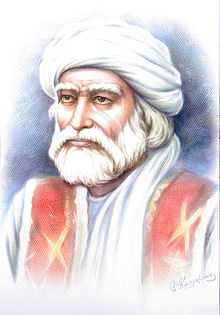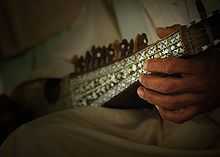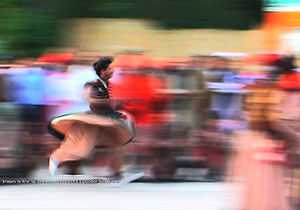Pashtun culture
 |
| Part of a series on |
| Pashtuns |
|---|
| Kingdoms |
| Religion |
Pashtun culture (Pashto: پښتني هڅوب) is based on Islam and Pashtunwali, which is an ancient way of life, as well as speaking of the Pashto language and wearing Pashtun dress. The culture of the Pashtun people is highlighted since at least the time of Herodotus (484-425 BC) or Alexander the Great, when he explored the Afghanistan and Pakistan region in 330 BC. The Pashtun culture has little outside influence and over the ages, has retained a great degree of purity.
Holidays and special events
The biggest holidays for Pashtuns is the Islamic Eid al-Fitr and Eid al-Adha, followed by Afghan Independence Day (August 19). The arrival of Sparlay or Spring, known as Naw-Wraz (New Day), is also celebrated by some Pashtuns. It is an ancient annual Pashtun festival which celebrates both the beginning of spring and the New Year. Amongst some Pashtuns, Sheshbeeyeh, a prelude festival to Nava Wroz is also celebrated. This tradition still survives, mainly amongst the southerners; in Bannu and Waziristan [1] During these holidays, Pashtuns set up festivals in which they usually attend mosques to make special prayers, have cookouts in parks, and go to fairs.
Pashto poetry

Afghanistan was noted for its poetic language even before the Islamic conquest of Afghanistan. The Pata Khazana contains Pashto poetry written as far back as the 8th Century. Some notable poets from the region of Afghanistan-Pakistan include Amir Kror Suri, Khushal Khan Khattak, Rahman Baba, Nazo Tokhi, Ahmad Shah Durrani, Timur Shah Durrani, Shuja Shah Durrani, Ghulam Muhammad Tarzi, Khan Abdul Ghani Khan, and many others.[2]
Pashtun men usually gather at special events and listen to Pashto poetry. There are TV programs which broadcast such events to the wider Pashtun audiences, one TV program is on AVT Khyber channel in Pakistan with Amanullah Kakar as the presenter.
Music and dances

Traditional Pashto music is mostly klasik ghazals, using rubab or sitar, tabla, portable harmonium, flute and several other musical instruments. Today's modern Pashto music is influenced by neighboring music such as Bollywood filmi as well as western or European.
Among the dozens of different folk dances known as Atanrh[3][4] (Pashto: اتڼ; ALA-LC Romanization: Ataṇ), also referred to as Atan or Attan, are the following:
Attan dance
In this dance, the dancers perform to the beat of the musician. This dance typically performed by men & women. It involves 2-5 steps, ending with a clap given while facing the center, after which the process is repeated again. The hip and arms are put in a sequential movement including left and right tilts, with the wrists twisting in sequence, with ultimately a hand is projected outward and brought in a 'scoop-like' fashion towards the center where the other hand meets it for a clap. This dance is typically performed with the musician dictating the duration and speed.
Khattak dance

The Khattak Dance is performed by the Khattak tribe, mainly in Pakistan but also in some eastern parts of Afghanistan.
Mahsud Attan (Dance)
A unique dance routine using rifles performed by the Mahsud tribe of Pashtuns. Originally it was used to dance at the time of war, but later on became a cultural dance. The dancers dance empty handed and require only large drums. Nowadays though it is danced with the guns in the dancers hand; loaded guns are taken in one hand, up to the beat of the drum the dancers move forward in a circle. After taking two and half steps, each dancer turns about, and cocks the gun. All the dancers do this in a uniform manner and by completing the turning steps they fire in the air simultaneously. The sound of each of the guns goes on one time and seems to be a single big bang.
Waziri dance
Waziristan is a large area and has particular Pashtun culture. Two drummers and a flute player play a particular tune. All the Wazirs standing around them. Two persons leave the circle; go dancing towards the drummers, and come back dancing in the same manner. During performing both the persons turn around two times at a time once towards each other facing face to face and once keeping faces in opposite direction. After doing this separately they march while dancing to the assembled crowd. As they reach the circle another pair of the performers start and moving forward in the same fashion.
Clothing

Pashtun men usually wear a Partoog-Korteh in Pashto(salwar kameez is Urdu)with a pakul (Pashtun hat). In the Kandahar region young men usually wear different type of hat similar to a topi and in the Peshawar region they wear white kufis instead. Leaders or tribal chiefs sometimes wear a karakul hat, like Hamid Karzai and others.
Women and girls wear traditional long dresses with a light piece of cloth used to cover their hair.
Cuisine
Sport
Cricket
Football
Buzkashi and polo
Some Pashtuns in Central Asia participate in buzkashi, which is a sport introduced in the region during the Mongol period from the 13th century and onward. The word "buz" means "goat" and "kashi" means "dragging" or "pulling" in the Persian language. The basic objective is to carry the headless carcass of a calf or goat around a flag and back to the starting point while on horseback with other riders trying to do the same thing by taking the carcass away from you. Not a team sport, it is every man for himself and that becomes apparent as soon as the game starts. It is played on a large open dusty field which does not appear to have many boundaries. The game is a microcosm of power politics in Afghanistan. Although buskashi is primarily an individual sport, alliances are built up between various players. Between the alliances, the strongest players finally take control (or in this case the remnants of a headless calf) and ride off to victory.
Gallery
-

Tents of Kuchi people in Badghis Province of Afghanistan
-
Young school girls in Paktia Province of Afghanistan
-

Students at Nad Ali district of Helmand Province in Afghanistan
-

Children at a park in Kandahar
-

Pashtun school girl sings a prayer in celebration and for blessing in Nangarhar Province
-

Boys in Spin Boldak
-

Pashtun boys in Paktika Province
-

Afghan governors discussing political matters
-

A father and his child walk down the street from the local farmers market in Asadabad
-

Pashtuns conducting their afternoon prayer in Kunar Province
-

Asadullah Khalid with students at Rahman Baba High School in Kabul
-

Pashtun man and his daughter dressed in traditional clothes
-

Tribal and religious leaders gather following a shura held in Kandahar by Afghan President Hamid Karzai
See also
Notes and references
- ↑ Lt. j.g. Keith Goodsell (March 7, 2011). "Key Afghan, US leadership plant trees for Farmer’s Day". United States Central Command. Retrieved 2012-12-03.
- ↑ Afghanistan Online, Classical Dari and Pashto Poets
- ↑
- ↑

